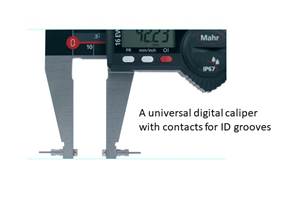Feels Like A Go To Me
Once a QC manager came to me, confused and dissatisfied. He was spending money to buy quality masters, but his inspection process was not improving.
Share








Takumi USA
Featured Content
View MoreOnce a QC manager came to me, confused and dissatisfied. He was spending money to buy quality masters, but his inspection process was not improving. Plus, his masters went out of calibration rapidly, pushing costs even higher. The problem was that he was buying more accuracy than he could use.
Choosing the right tool for the job is as important to mastering as to other areas of gaging. It may be possible to master a gage using a variety of standards, but the best master for a job has a balance between accuracy, economy, durability and ease of use.
Gage blocks are "primary standards" traceable to an "absolute" standard maintained by NIST, DIN or ISO. Masters are "secondary" standards; their sizes are established by reference to primary standards. Masters typically have a higher level of uncertainty, but they are often the right choice for production gaging. Gage blocks are square, while masters are often round. If the parts being measured are round and the gage is designed to measure round parts, the use of a round master will help avoid geometry error.
A master ring or ring gage is basically a bore of a known dimension. The same device can often be used as a setting master for variable inside-diameter gages (such as bore gages, air tooling and mechanical plug gages), for go/no-go mastering of fixed ID gages and for go/no-go OD inspection of male cylindrical workpieces.
Ring gages are made from steel, chromed steel for durability and corrosion resistance, or tungsten carbide for extreme wear resistance. They are classed by level of accuracy, with XXX indicating the tightest tolerances; XX, X and Y being intermediate grades; and Z being the lowest. Class tolerances vary by size: Larger sizes have higher levels of uncertainty. Tolerances may be bilateral for use in setting variable gages or unilateral for use as go/no-go gages. For rings, "go" is minus; for plugs, plus. Go/no-go gages may often be identified by a groove or ring on their knurled outside diameters.
Plug gages, for go/no-go measurements of part IDs or for mastering ID gages, are also available in different materials and classes. Plug gages may be reversible or double ended, with a "go" end signified by a green stripe and a "no go" end signified by a red stripe. Usually available only in sizes up to about 0.76", reversible plug gages can be disassembled to replace a worn end.
Plug gages are identified by the names of their handle or mounting designs. Taper-lock plug gages usually range from 0.059" to 1.510" and have a handle on one end. Tri-lock designs, also called discs, range from 1.510" to 8.010" and have handles on both ends. Annular designs, for sizes from 8.010" to 12.010", are like wagon wheels, with handles for axles.
Specialty masters are available for a range of applications and shapes, including slots, splines and tapers. Tool holder taper geometry is important in precision machining, and manufacturers are paying attention to taper quality. Taper plug gages can indicate if an ID taper is too steep or too shallow, or if the bore entry diameter is within tolerances. Inside and outside taper masters are used for setting taper air gaging. Such special-purpose masters make mastering and measuring quicker and easier, and they usually cost more.
Choose a master whose tolerance is 10 percent of the precision of the gage. The gage's precision and repeatability should be 10 percent of the part tolerance. It's usually not worthwhile to buy more accuracy than this "ten to one" rule: It costs more, it doesn't improve the accuracy and the master will lose calibration faster. On the other hand, when manufacturing to extremely tight tolerances, one might need a ratio of 4:1 or even 3:1 between gage and standard.
Here are some general guidelines for the care and feeding of masters: Store them in a secure place; use a wax- or oil-based sealant to protect against corrosion; handle carefully—don't force or jam them onto the part; don't try to modify them; and when shipping for calibration, take steps to protect masters against damage and corrosion.
Related Content
How to Calibrate Gages and Certify Calibration Programs
Tips for establishing and maintaining a regular gage calibration program.
Read MoreChoosing the Correct Gage Type for Groove Inspection
Grooves play a critical functional role for seal rings and retainer rings, so good gaging practices are a must.
Read More6 Machine Shop Essentials to Stay Competitive
If you want to streamline production and be competitive in the industry, you will need far more than a standard three-axis CNC mill or two-axis CNC lathe and a few measuring tools.
Read MoreProcess Control — Leveraging Machine Shop Connectivity in Real Time
Renishaw Central, the company’s new end-to-end process control software, offers a new methodology for producing families of parts through actionable data.
Read MoreRead Next
Registration Now Open for the Precision Machining Technology Show (PMTS) 2025
The precision machining industry’s premier event returns to Cleveland, OH, April 1-3.
Read MoreBuilding Out a Foundation for Student Machinists
Autodesk and Haas have teamed up to produce an introductory course for students that covers the basics of CAD, CAM and CNC while providing them with a portfolio part.
Read MoreSetting Up the Building Blocks for a Digital Factory
Woodward Inc. spent over a year developing an API to connect machines to its digital factory. Caron Engineering’s MiConnect has cut most of this process while also granting the shop greater access to machine information.
Read More





























.png;maxWidth=300;quality=90)
















